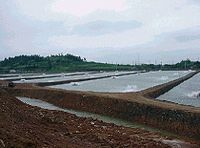
Photo from wikipedia
ABSTRACT A polyculture system composed of western white shrimp, Litopenaeus vannamei and Mullet, Mugil cephalus, was established to create favourable biological condition and improve shrimp growth. Totally, nine earthen ponds… Click to show full abstract
ABSTRACT A polyculture system composed of western white shrimp, Litopenaeus vannamei and Mullet, Mugil cephalus, was established to create favourable biological condition and improve shrimp growth. Totally, nine earthen ponds of 600 m2 (three treatments with three replicates) were prepared in the Gwadar area (located in the coastal area of Oman Sea, southeast of Iran) for our experiment. The L. vannamei post-larvae (PLs) (average body weight: 0.007 ± 0.001 g) were stocked at a density of 20 PLs m−2 in each experimental pond. After 40 days of storage, mullets with size of 20–50 cm were stocked at densities of 0 (T1), 2 (T2) and 4 (T3) fish per 100 m2 of ponds, respectively. The growth parameters (including: specific growth rate, mean weight), food conversion ratio (FCR) and survival rate (SR) of shrimps were measured during the experiment. After 107 days of the experiment, the highest shrimp biomass was obtained in T3 (212 kg) and T1 yielded the lowest biomass (187 kg). The mean body weight of each shrimp was 18.4 and 16.23 g in T3 and T1 , respectively (P < 0.05). The SR and FCR did not show significant differences between treatments (P > 0.05). In conclusion, the present experiment demonstrated that polyculture of western white shrimp with mullet improves growth and subsequently the production of western shrimp.
Journal Title: Journal of Applied Animal Research
Year Published: 2017
Link to full text (if available)
Share on Social Media: Sign Up to like & get
recommendations!